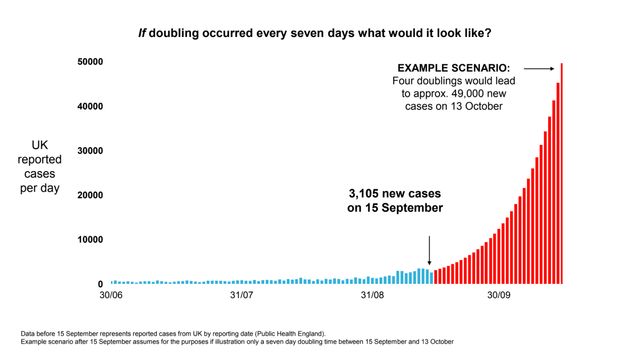Chief scientific officer Patrick Vallance has warned there could be 50,000 daily cases of Covid-19 by mid-October and 200 deaths a day by mid-November if the current rate of infection is not halted.
Speaking at a snap public briefing in Downing Street on Monday alongside chief medical officer Chris Whitty, Vallance laid out what the country is facing if cases continue to rise at the same rate.
It comes after Boris Johnson warned on Friday that a second wave “is coming” to the UK.
Vallance cautioned coronavirus cases were rising across Europe – and that was leading to a mounting daily death toll.
There was a “simple message” that “as the disease spreads, as it spreads across age groups, we expect to see increasing hospitalisations and unfortunately, those increasing hospitalisations will lead to increasing deaths”, he said.
Last week, the all important R rate of the virus, which shows whether the pandemic is growing, jumped to between 1.1 and 1.4 and the daily positive case number went over 4,000 for the first time since May.
“At the moment we think the epidemic is doubling roughly every seven days,” Vallance said.
“If, and that’s quite a big if, but if that continues unabated and this grows doubling every seven days… if that continued you would end up with something like 50,000 cases in the middle of October per day.

“Fifty thousand cases per day would be expected to lead a month later, so the middle of November say, to 200-plus deaths per day.
“The challenge therefore is to make sure the doubling time does not stay at seven days.”
Whitty, meanwhile, said there was a “rate of increase across the great majority of the country” and that Brits could expect curbs on socialising for six months.
He said: “It is going at different rates but it is now increasing.”
The chief medical officer also warned with winter approaching “the seasons are against us”, adding that “we’re now going into the seasons – late autumn and winter – which benefit respiratory viruses, and it is very likely they will benefit Covid, as they do, for example, flu”.
He said: “So we should see this as a six-month problem that we have to deal with collectively, it’s not indefinite.”
He said there was “no evidence” that the virus was a milder strain than in April, instead suggesting that the rates had increased among younger adults who were less likely to develop a severe case of Covid-19.
Whitty added that mortality rates from Covid-19 were “significantly greater” than seasonal flu, which killed around 7,000 annually or 20,000 in a bad year.
“This virus is more virulent than flu so the numbers people talk about are not unreasonable numbers for us to be thinking about,” he said, and while treatment was better it could not take mortality down to “trivial” levels.

Bearing down on the disease “requires speed [and] it requires action”, Vallance said, to curb the spread amongst vulnerable people.
He said “in every age group we’ve seen an increase”, adding this is not due to more testing, because of an increase in test positivity and results of the ONS study, which says around 70,000 people in the UK have Covid-19.
Underlining that in Spain and France “it started with younger people in their 20s and spread gradually to older ages as well”, he went on: “That increasing case number has translated into an increase in hospitalisations.
“As the hospitalisations have increased… very sadly, but not unexpectedly, deaths are also increasing.”
Whitty also hinted at more home-working for people, saying government must “break unnecessary links between households”.
He said: “Reducing social contacts, whether they are at work… and also in social environments.
“We have to try and do this in the least damaging way.”
The government has introduced a new “rule of six” on social gatherings and hefty £10,000 fines for those who fail to self-isolate.
On Monday, Matt Hancock has refused to guarantee that pubs will be open this weekend. The health secretary said there would be no return to the full lockdown seen in March, however, stressing restrictions would be “different to last time”.